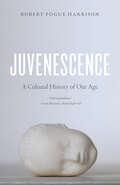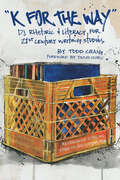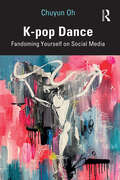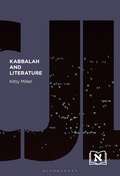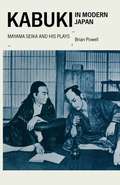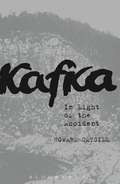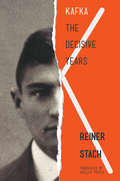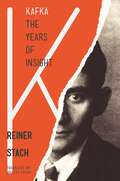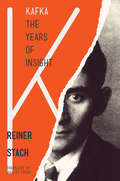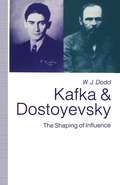- Table View
- List View
Juvenescence: A Cultural History of Our Age
by Robert Pogue HarrisonHow old are you? The more thought you bring to bear on the question, the harder it is to answer. For we age simultaneously in different ways: biologically, psychologically, socially. And we age within the larger framework of a culture, in the midst of a history that predates us and will outlast us. Looked at through that lens, many aspects of late modernity would suggest that we are older than ever, but Robert Pogue Harrison argues that we are also getting startlingly younger—in looks, mentality, and behavior. We live, he says, in an age of juvenescence. Like all of Robert Pogue Harrison's books, Juvenescence ranges brilliantly across cultures and history, tracing the ways that the spirits of youth and age have inflected each other from antiquity to the present. Drawing on the scientific concept of neotony, or the retention of juvenile characteristics through adulthood, and extending it into the cultural realm, Harrison argues that youth is essential for culture’s innovative drive and flashes of genius. At the same time, however, youth—which Harrison sees as more protracted than ever—is a luxury that requires the stability and wisdom of our elders and the institutions. “While genius liberates the novelties of the future,” Harrison writes, “wisdom inherits the legacies of the past, renewing them in the process of handing them down.” A heady, deeply learned excursion, rich with ideas and insights, Juvenescence could only have been written by Robert Pogue Harrison. No reader who has wondered at our culture's obsession with youth should miss it.
The Juvenile Tradition: Young Writers and Prolepsis, 1750-1835
by Laurie LangbauerA juvenile tradition of young writers flourished in Britain between 1750-1835. Canonical Romantic poets as well as now-unknown youthful writers published as teenagers. These teenage writers reflected on their literary juvenilia by using the trope of prolepsis to assert their writing as a literary tradition. Precocious writing, child prodigies, and early genius had been topics of interest since the eighteenth century. Child authors—girl poets and boy poets, schoolboy writers and undergraduate writers, juvenile authors of all kinds—found new publication opportunities because of major shifts in the periodical press, publishing, and education. School magazines and popular juvenile magazines that awarded prizes to child writers all made youthful authorship more visible. Some historians estimate that minors (children and teens) comprised over half the population at the beginning of the nineteenth century. Modern interest in Romanticism, and the self-taught and women writers' traditions, has occluded the tradition of juvenile writers. This first full-length study to recover the late-eighteenth and early-nineteenth-century juvenile tradition draws on the history of childhood and child studies, along with reception study and audience history. It considers the literary juvenilia of Thomas Chatterton, Henry Kirke White, Robert Southey, Leigh Hunt, Jane Austen, and Felicia Hemans (then Felicia Dorothea Browne)-along with the childhood writing of Byron, Mary Shelley, Percy Shelley, and John Keats-and a score of other young poets- "infant bards "-no longer familiar today. Recovering juvenility recasts literary history. Adolescent writers, acting proleptically, ignored the assumptions of childhood development and the disparagement of supposedly immature writing.
K (Vintage International Series)
by Roberto CalassoWhat are Kafka's stories about? Are they dreams? Allegories? Symbols? Things that happen every day? But where and when? In this remarkable book, Roberto Calasso sets out not to dispel the mystery but to let it be illuminated by its own light. With his unique vision, imagination, and intellectual acumen, Calasso attempts to enter the flow, the tortuous movement, the physiology of the stories to discover what they are meant to signify and to delve into the most basic question: Who is K.? The culmination of the author's lifelong fascination with Kafka, K. is a book of significant literary importance, the fourth part in a work in progress of which the previous volumes are The Ruin of Kasch, The Marriage of Cadmus and Harmony, and Ka.
K. (Penguin Modern Classics)
by Roberto CalassoWhat are Kafka's stories about? Are they dreams? Allegories? Symbols? Things that happen every day? But where and when?In this remarkable book, Roberto Calasso sets out not to dispel the mystery but to let it be illuminated by its own light. With his unique vision, imagination, and intellectual acumen, Calasso attempts to enter the flow, the tortuous movement, the physiology of the stories to discover what they are meant to signify and to delve into the most basic question: Who is K.?
K-12 Classroom Research in Language Teaching and Learning: Narratives for Understanding and Engaging in Teacher Research (Routledge Research in Language Education)
by Khanh-Duc KuttigThis edited volume presents narratives on a range of methods for research on second language teaching and learning appropriate to the elementary, middle, and high schools (K-12). Teacher researchers in different worldwide contexts narrate their processes to explain and demonstrate practitioner research in context; contributors describe their research from exploring the rationale for the project, to designing the study, analyzing the data, and disseminating it. As such, the book illustrates how K-12 practitioners design, gather, analyze, interpret, and strategically employ data to make data-driven, evidence-based, and analysis-informed instructional, assessment, and programmatic decisions. This volume empowers teacher-researchers and allows them to envision research projects in their own classrooms. Offering new insights into the researchers’ thinking processes, challenges, and solutions, and advocating teacher research for understanding learning, the teaching of language, and the development of SLA, this text will appeal to educators and researchers involved in language education, second language acquisition, TESOL, ESL/EFL/ELT, and applied linguistics.
K-12 Classroom Research in Language Teaching and Learning: Narratives for Understanding and Engaging in Teacher Research (Routledge Research in Language Education)
This edited volume presents narratives on a range of methods for research on second language teaching and learning appropriate to the elementary, middle, and high schools (K-12). Teacher researchers in different worldwide contexts narrate their processes to explain and demonstrate practitioner research in context; contributors describe their research from exploring the rationale for the project, to designing the study, analyzing the data, and disseminating it. As such, the book illustrates how K-12 practitioners design, gather, analyze, interpret, and strategically employ data to make data-driven, evidence-based, and analysis-informed instructional, assessment, and programmatic decisions. This volume empowers teacher-researchers and allows them to envision research projects in their own classrooms. Offering new insights into the researchers’ thinking processes, challenges, and solutions, and advocating teacher research for understanding learning, the teaching of language, and the development of SLA, this text will appeal to educators and researchers involved in language education, second language acquisition, TESOL, ESL/EFL/ELT, and applied linguistics.
"K for the Way": DJ Rhetoric and Literacy for 21st Century Writing Studies
by Todd Craig“K for the Way” explores writing, rhetoric, and literacy from the perspective of the Hip Hop DJ. Todd Craig, a DJ himself, establishes and investigates the function of DJ rhetoric and literacy, illuminating the DJ as a fruitful example for (re)envisioning approaches to writing, research, and analysis in contemporary educational settings. Because it is widely recognized that the DJ was the catalyst for the creation of Hip Hop culture, this book begins a new conversation in which Hip Hop DJs introduce ideas about poetics and language formation through the modes, practices, and techniques they engage in on a daily basis. Using material from a larger qualitative research study that illustrates the Hip Hop DJ as a twenty-first-century new media reader, writer, and literary critic, Craig blends interviews from prominent and influential DJs in the Hip Hop community with narrative and interdisciplinary scholarship from writing studies, Hip Hop studies, African American studies, urban education, and ethnomusicology. The voices of DJs sit front and center, presenting a revolutionary conversation about writing and communication in the twenty-first century. Weaving Craig’s life experiences with important discussions of racial literacies, “K for the Way” is a layered and utterly singular exploration of culture, identity, and literacy in America.
K. O. Mbadiwe: A Nigerian Political Biography, 1915–1990
by Hollis R. LynchThis book offers a comprehensive political biography of Kingsley Ozuomba Mbadiwe, (1915-1990), a central figure in Nigerian political history for more than forty years. Starting in 1936 as a protégé of Nnamdi Azikiwe, then Nigeria's most renowned nationalist, Mbadiwe himself by the 1950s became a frontline nationalist. And next to Tafawa Balewa from the North who became Prime Minster in 1957, he was the most important figure in the Nigerian Federal Government between 1952 and Nigeria's first military coup in 1966. During this time he held a succession of important Cabinet positions and was Parliamentary Leader of the National Council of Nigeria and the Cameroons (NCNC), which was in a ruling alliance with the Northern People's Congress (NPC). In contrast, his older prominent political contemporaries, Azikiwe of the Eastern Region, Igbo Leader of the NCNC; Obafemi Awolowo of the Western Region, Yoruba Leader of the Action Group (AG); and Ahmadu Bello of the Northern Region, Fulani Leader of the NPC, all carved out their political careers totally or largely at the regional level. Throughout his political career Mbadiwe's focus was always at the national level. Truly, it has been stated that Mbadiwe was one of the founding fathers of the Nigerian State. Nonetheless, Mbadiwe's ambition for himself to lead Nigeria and for his nation to set it on the path to greatness faced insuperable difficulties. In a country of widespread poverty, high illiteracy, and a grossly underdeveloped private sector, there were fierce ethnic and regional conflicts for the control of governments and resources, leading to massive corruption and serious instability. This in turn led to prolonged military rule twenty years in Mbadiwe's lifetime which was often more corrupt and repressive than civilian rule, and was bitterly deprecated by Mbadiwe.
K-pop Dance: Fandoming Yourself on Social Media
by Chuyun OhThis book is about K-pop dance and the evolution and presence of its dance fandom on social media. Based on five years of ethnographic fieldwork, interviews, choreography, and participation-observation with 40 amateur and professional K-pop dancers in New York, California, and Seoul, the book traces the evolution of K-pop dance from the 1980s to the 2020s and explains its distinctive feature called ‘gestural point choreography’ – front-driven, two-dimensional, decorative and charming movements of the upper body and face – as an example of what the author theorizes as ‘social media dance.’ It also explores K-pop cover dance as a form of intercultural performance, suggesting that, by imitating and idolizing K-pop dance, fans are eventually ‘fandoming’ themselves and their bodies. Presenting an ethnographic study of K-pop dance and its fandom, this book will be a valuable resource for students and scholars of Media Studies, Korean Studies, Performance Studies, and Dance.
K-pop Dance: Fandoming Yourself on Social Media
by Chuyun OhThis book is about K-pop dance and the evolution and presence of its dance fandom on social media. Based on five years of ethnographic fieldwork, interviews, choreography, and participation-observation with 40 amateur and professional K-pop dancers in New York, California, and Seoul, the book traces the evolution of K-pop dance from the 1980s to the 2020s and explains its distinctive feature called ‘gestural point choreography’ – front-driven, two-dimensional, decorative and charming movements of the upper body and face – as an example of what the author theorizes as ‘social media dance.’ It also explores K-pop cover dance as a form of intercultural performance, suggesting that, by imitating and idolizing K-pop dance, fans are eventually ‘fandoming’ themselves and their bodies. Presenting an ethnographic study of K-pop dance and its fandom, this book will be a valuable resource for students and scholars of Media Studies, Korean Studies, Performance Studies, and Dance.
Kabbalah and Literature (Comparative Jewish Literatures)
by Professor Kitty MilletFocuses on a range of Jewish and non-Jewish writers to examine the intersection of Kabbalah, the Jewish mystical tradition, and secular Jewish literatures.Kabbalah and Literature shows how the Jewish mystical tradition contributes to the renewal of literature in a modern, global, and increasingly disconnected age. Kitty Millet explores Kabbalah's conceptual underpinnings, aesthetic principles, tenets, and signifiers to demonstrate how literature's absorption of kabbalistic material has altered its ontology, function, and the tasks it sets for itself. Reading writers from Europe and the Americas, Kitty Millet maps how the kabbalist's desire to "recover Eden" transforms into a latent messianic drive only intuitable through text. Thus it charts a journey of sorts, a migration of Jewish mystical material embedded surreptitiously within text in order to shift ever so slightly at times the range of the literary to encompass an aesthetic vision not easily reducible to the literal, the known, the allegorical, or even the philosophical.In this way, Kabbalah and Literature proposes a novel, intuitive approach, shifting focus away from the Jewish text's epistemological elements to embrace its "secrets."
Kabbalah and Literature (Comparative Jewish Literatures)
by Professor Kitty MilletFocuses on a range of Jewish and non-Jewish writers to examine the intersection of Kabbalah, the Jewish mystical tradition, and secular Jewish literatures.Kabbalah and Literature shows how the Jewish mystical tradition contributes to the renewal of literature in a modern, global, and increasingly disconnected age. Kitty Millet explores Kabbalah's conceptual underpinnings, aesthetic principles, tenets, and signifiers to demonstrate how literature's absorption of kabbalistic material has altered its ontology, function, and the tasks it sets for itself. Reading writers from Europe and the Americas, Kitty Millet maps how the kabbalist's desire to "recover Eden" transforms into a latent messianic drive only intuitable through text. Thus it charts a journey of sorts, a migration of Jewish mystical material embedded surreptitiously within text in order to shift ever so slightly at times the range of the literary to encompass an aesthetic vision not easily reducible to the literal, the known, the allegorical, or even the philosophical.In this way, Kabbalah and Literature proposes a novel, intuitive approach, shifting focus away from the Jewish text's epistemological elements to embrace its "secrets."
Kafka: In Light of the Accident
by Howard CaygillBy challenging many of the assumptions, misguided presuppositions and even legends that have surrounded the legacy and reception of Franz Kafka's work during the 20th century, Howard Caygill provides us with a radical new way of reading Kafka. Kafka: In the Light of the Accident advances a unique philosophical interpretation via the pivotal theme of the accident, understood both philosophically and in a broader cultural context, that includes the philosophical and sociological basis of accident insurance and the understanding of the concepts of chance and necessity. Caygill reveals how Kafka's reception was governed by a series of accidents - from the order of Max Brod's posthumous publication of the novels and the correction of 'misprints', to many other posthumous editorial strategies. The focus on the accident casts light on the role of media in Kafka's work, particularly visual media and above all photography. By stressing the role of contingency in his authorship, Caygill also fundamentally questions the 20th century view of Kafka's work as 'kafkaesque'. Instead of a narration of domination, Kafka: In the Light of the Accident argues that Kafka's work is best read as a narration of defiance, one which affirms (often comically) the role of error and contingency in historical struggle. Kafka's defiance is situated within early 20th century radical culture, with particular emphasis lent to the roles of radical Judaism, the European socialist and feminist movements, and the subaltern histories of the United States and China.
Kafka: In Light of the Accident
by Howard CaygillBy challenging many of the assumptions, misguided presuppositions and even legends that have surrounded the legacy and reception of Franz Kafka's work during the 20th century, Howard Caygill provides us with a radical new way of reading Kafka. Kafka: In the Light of the Accident advances a unique philosophical interpretation via the pivotal theme of the accident, understood both philosophically and in a broader cultural context, that includes the philosophical and sociological basis of accident insurance and the understanding of the concepts of chance and necessity. Caygill reveals how Kafka's reception was governed by a series of accidents - from the order of Max Brod's posthumous publication of the novels and the correction of 'misprints', to many other posthumous editorial strategies. The focus on the accident casts light on the role of media in Kafka's work, particularly visual media and above all photography. By stressing the role of contingency in his authorship, Caygill also fundamentally questions the 20th century view of Kafka's work as 'kafkaesque'. Instead of a narration of domination, Kafka: In the Light of the Accident argues that Kafka's work is best read as a narration of defiance, one which affirms (often comically) the role of error and contingency in historical struggle. Kafka's defiance is situated within early 20th century radical culture, with particular emphasis lent to the roles of radical Judaism, the European socialist and feminist movements, and the subaltern histories of the United States and China.
Kafka: A Guide For The Perplexed (Guides for the Perplexed #218)
by Clayton KoelbFranz Kafka is one of the most widely taught, and read, writers in world literature. Readers encountering texts like 'The Metamorphosis' and The Trial for the first time are frequently perplexed by his often intentionally weird writing. Some might say that Kafka's enduring achievement has been to make his readers love being perplexed. As much of Kafka's writing is designed to perplex the reader, this guide helps the reader understand why and how perplexity has been deliberately created by Kafka's text and to realize what the uses of such perplexity might be. The book guides readers through their first encounters with Kafka and introduces the problems involved in reading his texts, the nature of his texts from the key novels and novellas to letters and professional writings, his life as a writer and different approaches to reading Kafka.
Kafka: A Guide For The Perplexed (Guides for the Perplexed #218)
by Clayton KoelbFranz Kafka is one of the most widely taught, and read, writers in world literature. Readers encountering texts like 'The Metamorphosis' and The Trial for the first time are frequently perplexed by his often intentionally weird writing. Some might say that Kafka's enduring achievement has been to make his readers love being perplexed. As much of Kafka's writing is designed to perplex the reader, this guide helps the reader understand why and how perplexity has been deliberately created by Kafka's text and to realize what the uses of such perplexity might be. The book guides readers through their first encounters with Kafka and introduces the problems involved in reading his texts, the nature of his texts from the key novels and novellas to letters and professional writings, his life as a writer and different approaches to reading Kafka.
Kafka: The Decisive Years
by Reiner StachThis is the acclaimed central volume of the definitive biography of Franz Kafka. Reiner Stach spent more than a decade working with over four thousand pages of journals, letters, and literary fragments, many never before available, to re-create the atmosphere in which Kafka lived and worked from 1910 to 1915, the most important and best-documented years of his life. This period, which would prove crucial to Kafka's writing and set the course for the rest of his life, saw him working with astonishing intensity on his most seminal writings--The Trial, The Metamorphosis, The Man Who Disappeared (Amerika), and The Judgment. These are also the years of Kafka's fascination with Zionism; of his tumultuous engagement to Felice Bauer; and of the outbreak of World War I. Kafka: The Decisive Years is at once an extraordinary portrait of the writer and a startlingly original contribution to the art of literary biography.
Kafka: The Years of Insight
by Reiner StachTelling the story of Kafka's final years as never before—the third volume in the acclaimed definitive biographyThis volume of Reiner Stach's acclaimed and definitive biography of Franz Kafka tells the story of the final years of the writer's life, from 1916 to 1924—a period during which the world Kafka had known came to an end. Stach's riveting narrative, which reflects the latest findings about Kafka's life and works, draws readers in with nearly cinematic precision, zooming in for extreme close-ups of Kafka's personal life, then pulling back for panoramic shots of a wider world blighted by World War I, disease, and inflation.In these years, Kafka was spared military service at the front, yet his work as a civil servant brought him into chilling proximity with its grim realities. He was witness to unspeakable misery, lost the financial security he had been counting on to lead the life of a writer, and remained captive for years in his hometown of Prague. The outbreak of tuberculosis and the collapse of the Austro-Hungarian Empire constituted a double shock for Kafka, and made him agonizingly aware of his increasing rootlessness. He began to pose broader existential questions, and his writing grew terser and more reflective, from the parable-like Country Doctor stories and A Hunger Artist to The Castle.A door seemed to open in the form of a passionate relationship with the Czech journalist Milena Jesenská. But the romance was unfulfilled and Kafka, an incurably ill German Jew with a Czech passport, continued to suffer. However, his predicament only sharpened his perceptiveness, and the final period of his life became the years of insight.
Kafka: The Decisive Years
by Reiner Stach Shelley FrischThis is the acclaimed central volume of the definitive biography of Franz Kafka. Reiner Stach spent more than a decade working with over four thousand pages of journals, letters, and literary fragments, many never before available, to re-create the atmosphere in which Kafka lived and worked from 1910 to 1915, the most important and best-documented years of his life. This period, which would prove crucial to Kafka's writing and set the course for the rest of his life, saw him working with astonishing intensity on his most seminal writings--The Trial, The Metamorphosis, The Man Who Disappeared (Amerika), and The Judgment. These are also the years of Kafka's fascination with Zionism; of his tumultuous engagement to Felice Bauer; and of the outbreak of World War I. Kafka: The Decisive Years is at once an extraordinary portrait of the writer and a startlingly original contribution to the art of literary biography.
Kafka: The Years of Insight
by Reiner Stach Shelley FrischThis volume of Reiner Stach's acclaimed and definitive biography of Franz Kafka tells the story of the final years of the writer's life, from 1916 to 1924--a period during which the world Kafka had known came to an end. Stach's riveting narrative, which reflects the latest findings about Kafka's life and works, draws readers in with nearly cinematic precision, zooming in for extreme close-ups of Kafka's personal life, then pulling back for panoramic shots of a wider world blighted by World War I, disease, and inflation. In these years, Kafka was spared military service at the front, yet his work as a civil servant brought him into chilling proximity with its grim realities. He was witness to unspeakable misery, lost the financial security he had been counting on to lead the life of a writer, and remained captive for years in his hometown of Prague. The outbreak of tuberculosis and the collapse of the Austro-Hungarian Empire constituted a double shock for Kafka, and made him agonizingly aware of his increasing rootlessness. He began to pose broader existential questions, and his writing grew terser and more reflective, from the parable-like Country Doctor stories and A Hunger Artist to The Castle. A door seemed to open in the form of a passionate relationship with the Czech journalist Milena Jesenská. But the romance was unfulfilled and Kafka, an incurably ill German Jew with a Czech passport, continued to suffer. However, his predicament only sharpened his perceptiveness, and the final period of his life became the years of insight.
Kafka: The Early Years
by Reiner Stach Shelley FrischHow did Kafka become Kafka? This eagerly anticipated third and final volume of Reiner Stach's definitive biography of the writer answers that question with more facts and insight than ever before, describing the complex personal, political, and cultural circumstances that shaped the young Franz Kafka (1883–1924). It tells the story of the years from his birth in Prague to the beginning of his professional and literary career in 1910, taking the reader up to just before the breakthrough that resulted in his first masterpieces, including "The Metamorphosis." Brimming with vivid and often startling details, Stach’s narrative invites readers deep inside this neglected period of Kafka’s life. The book’s richly atmospheric portrait of his German Jewish merchant family and his education, psychological development, and sexual maturation draws on numerous sources, some still unpublished, including family letters, schoolmates’ memoirs, and early diaries of his close friend Max Brod. The biography also provides a colorful panorama of Kafka’s wider world, especially the convoluted politics and culture of Prague. Before World War I, Kafka lived in a society at the threshold of modernity but torn by conflict, and Stach provides poignant details of how the adolescent Kafka witnessed violent outbreaks of anti-Semitism and nationalism. The reader also learns how he developed a passionate interest in new technologies, particularly movies and airplanes, and why another interest—his predilection for the back-to-nature movement—stemmed from his “nervous” surroundings rather than personal eccentricity. The crowning volume to a masterly biography, this is an unmatched account of how a boy who grew up in an old Central European monarchy became a writer who helped create modern literature.
Kafka: The Early Years
by Reiner Stach Shelley FrischHow did Kafka become Kafka? This eagerly anticipated third and final volume of Reiner Stach's definitive biography of the writer answers that question with more facts and insight than ever before, describing the complex personal, political, and cultural circumstances that shaped the young Franz Kafka (1883–1924). It tells the story of the years from his birth in Prague to the beginning of his professional and literary career in 1910, taking the reader up to just before the breakthrough that resulted in his first masterpieces, including "The Metamorphosis." Brimming with vivid and often startling details, Stach’s narrative invites readers deep inside this neglected period of Kafka’s life. The book’s richly atmospheric portrait of his German Jewish merchant family and his education, psychological development, and sexual maturation draws on numerous sources, some still unpublished, including family letters, schoolmates’ memoirs, and early diaries of his close friend Max Brod. The biography also provides a colorful panorama of Kafka’s wider world, especially the convoluted politics and culture of Prague. Before World War I, Kafka lived in a society at the threshold of modernity but torn by conflict, and Stach provides poignant details of how the adolescent Kafka witnessed violent outbreaks of anti-Semitism and nationalism. The reader also learns how he developed a passionate interest in new technologies, particularly movies and airplanes, and why another interest—his predilection for the back-to-nature movement—stemmed from his “nervous” surroundings rather than personal eccentricity. The crowning volume to a masterly biography, this is an unmatched account of how a boy who grew up in an old Central European monarchy became a writer who helped create modern literature.
Kafka and Dostoyevsky: The Shaping of Influence
by W.J. DoddThis book evaluates the importance of Dostoyevsky's life and imaginative fiction as a stimulus to Kafka's own writing. Dostoyevskian material is situated within detailed readings of particular works. The principle sources discussed are The Double, Notes from Underground, Crime and Punishment, and Dostoyevsky's (auto) biography. It is argued that Kafka's use of Dostoyevsky is driven by antagonism as much as by admiration.
